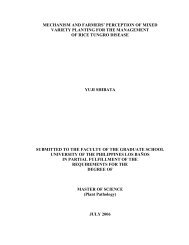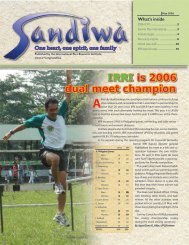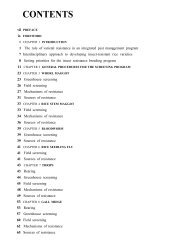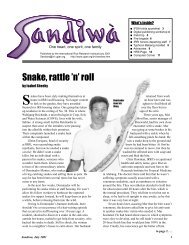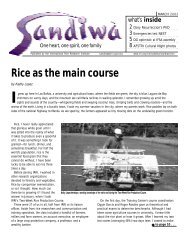Untitled - International Rice Research Institute
Untitled - International Rice Research Institute
Untitled - International Rice Research Institute
You also want an ePaper? Increase the reach of your titles
YUMPU automatically turns print PDFs into web optimized ePapers that Google loves.
Fig. 38. Occurrence of black kernel (Ou 1985, CABI/EPPO 1997).<br />
c. Location on seed<br />
Curvularia sp. is observed most often on the<br />
lemma and/or palea (about 66%) of the seed (Fig.<br />
41).<br />
Microscopic character<br />
a. Mycelia—septated, branched, subhyaline to light<br />
brown, in some cases dark brown (Fig. 40d).<br />
b. Conidiophores—dark brown, unbranched, septate,<br />
sometimes bent and knotted at the tip (Fig. 40e).<br />
c. Conidia—dark brown, boat-shaped, rounded at the<br />
tip, mostly a little constricted at the base; with<br />
hilum scarcely or not at all protuberant, smoothwalled,<br />
light to dark brown, with three septa; the<br />
2nd cell is larger than the 1st, 3rd, and 4th cells;<br />
bent on the 2nd cell; borne at the tip, arranged in a<br />
whorl one over another or more or less spirally<br />
arranged or in thick panicles (Fig. 40f). Measurements:<br />
16.33–24.84 µ × 7.36–13.34 µ (PDA);<br />
17.48–27.37 µ × 8.28–13.11 µ (PSA); and 15.64–<br />
26.91 µ × 7.36–12.65 µ (MEA).<br />
Colony characters on culture media (Fig. 42)<br />
Colonies on PDA at ART (28–30 °C) grow fast and<br />
attain an 8.40-cm diam in 5 d. Colonies are zonated<br />
and felted; the conidial area is greenish gray with a 3-<br />
mm sterile advancing margin and abundant grayish<br />
mycelial tufts. The colony appearance on the reverse<br />
side of the agar plate is zonated and gray. At 21 °C<br />
under alternating 12-h NUV light and 12-h darkness,<br />
colonies grow moderately fast and attain a 5.94-cm<br />
diam in 5 d. They are cottony to slightly felted with<br />
slight radial furrows and 5-mm even, sterile margins,<br />
zonated, and black, becoming gray toward the margins.<br />
The colony appearance on the reverse side of<br />
the agar plate appears zonated and black at the center<br />
and lighter outward. At 28 °C under alternating<br />
12-h fluorescent light and 12-h darkness, colonies<br />
grow very fast and attain an 8.30-cm diam in 5 d.<br />
Colonies are zonated, hairy to slightly felted, and the<br />
conidial area is olive gray to greenish gray with a 2-<br />
mm sterile white margin. The colony appearance on<br />
the reverse side of the agar plate is slightly zonated<br />
and black.<br />
Colonies on PSA at ART (28–30 °C) grow very<br />
fast and attain an 8.50-cm diam in 5 d. They are<br />
slightly zonated, slightly cottony, and somewhat depressed<br />
to the media. The conidial area is black with<br />
3-mm sterile white margins becoming black as<br />
conidia are produced. The colony on the reverse side<br />
of the agar plate appears zonated and slightly black.<br />
At 21 °C under alternating 12-h NUV light and 12-h<br />
darkness, colonies grow fast and attain a 6.91-cm<br />
diam in 5 d. They are zonated, slightly cottony, with a<br />
39



